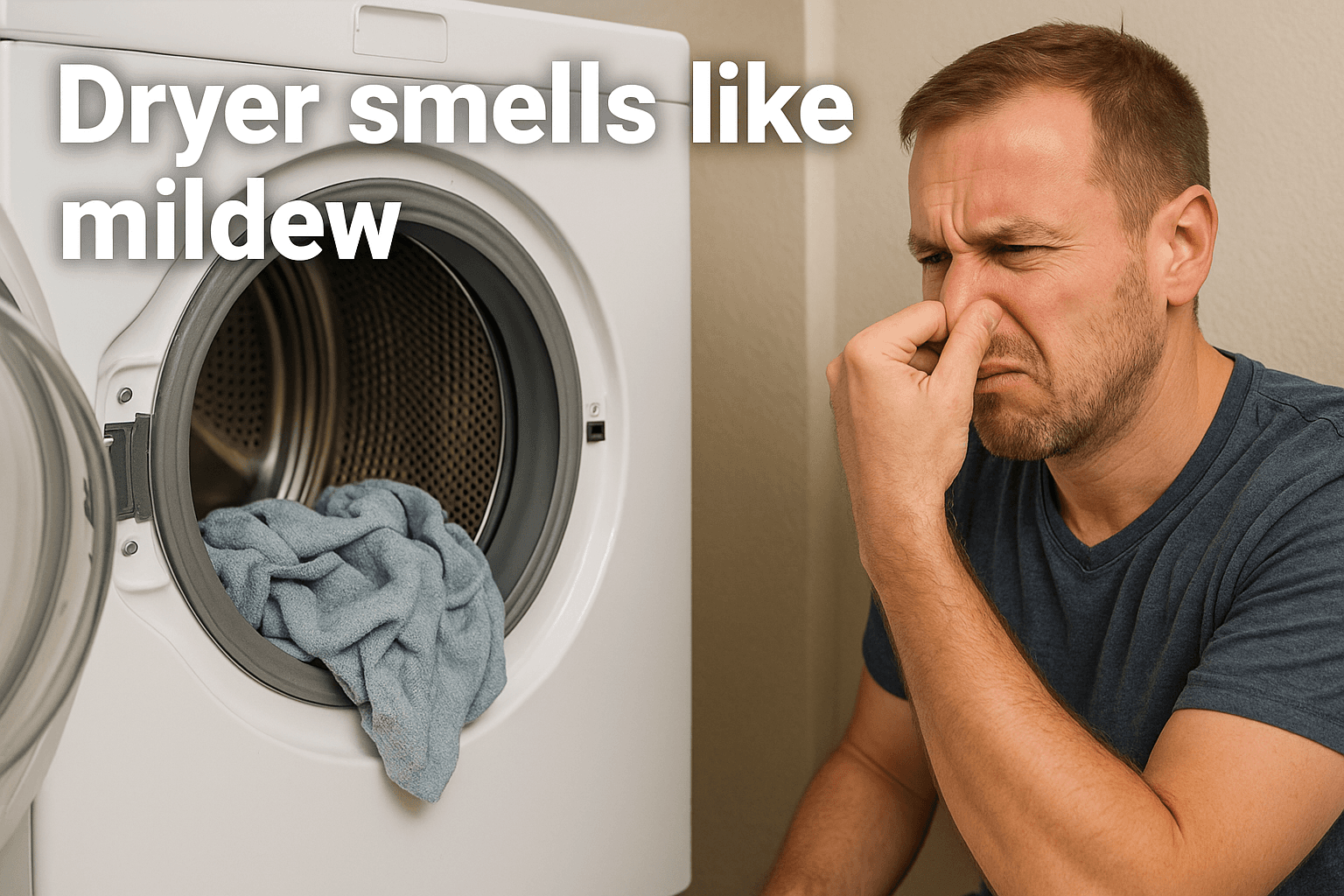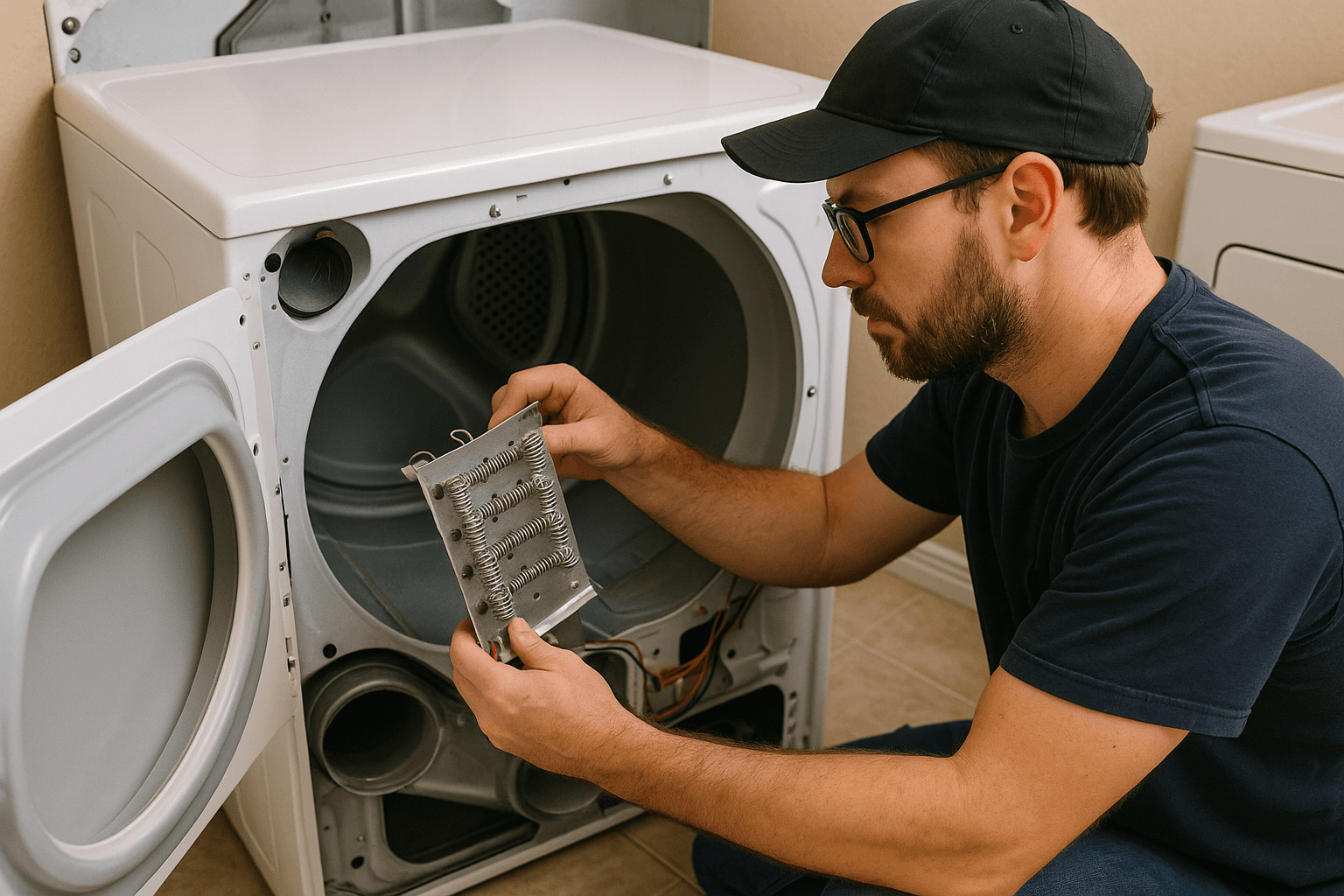Repair help
Burning Smell From Dryer? Causes and How to Fix It Safely
AZparts Team
Updated on July 17, 2025
10 min read
A burning smell from your dryer is more than just an unpleasant odor – it's a potential safety hazard that requires immediate attention. Whether you're dealing with a faint burning scent or a strong acrid smell, understanding the root causes and knowing how to address them safely can prevent serious damage to your appliance and protect your home from fire risks. At AZParts, we understand the importance of maintaining your dryer's safety and performance with quality replacement parts and expert guidance.

1. What Causes a Burning Smell From a Dryer?
Understanding the source of burning smells helps you address the problem effectively and prevent future occurrences. Here are the most common culprits behind that alarming odor.
1.1 Clogged Lint Filter
The lint filter is your dryer's first line of defense against debris buildup. When lint accumulates beyond normal levels, it restricts airflow and creates excessive heat. This trapped lint can begin to smolder or burn, producing that distinctive burning smell. A clogged filter forces your dryer to work harder, generating more heat than the system can safely handle.
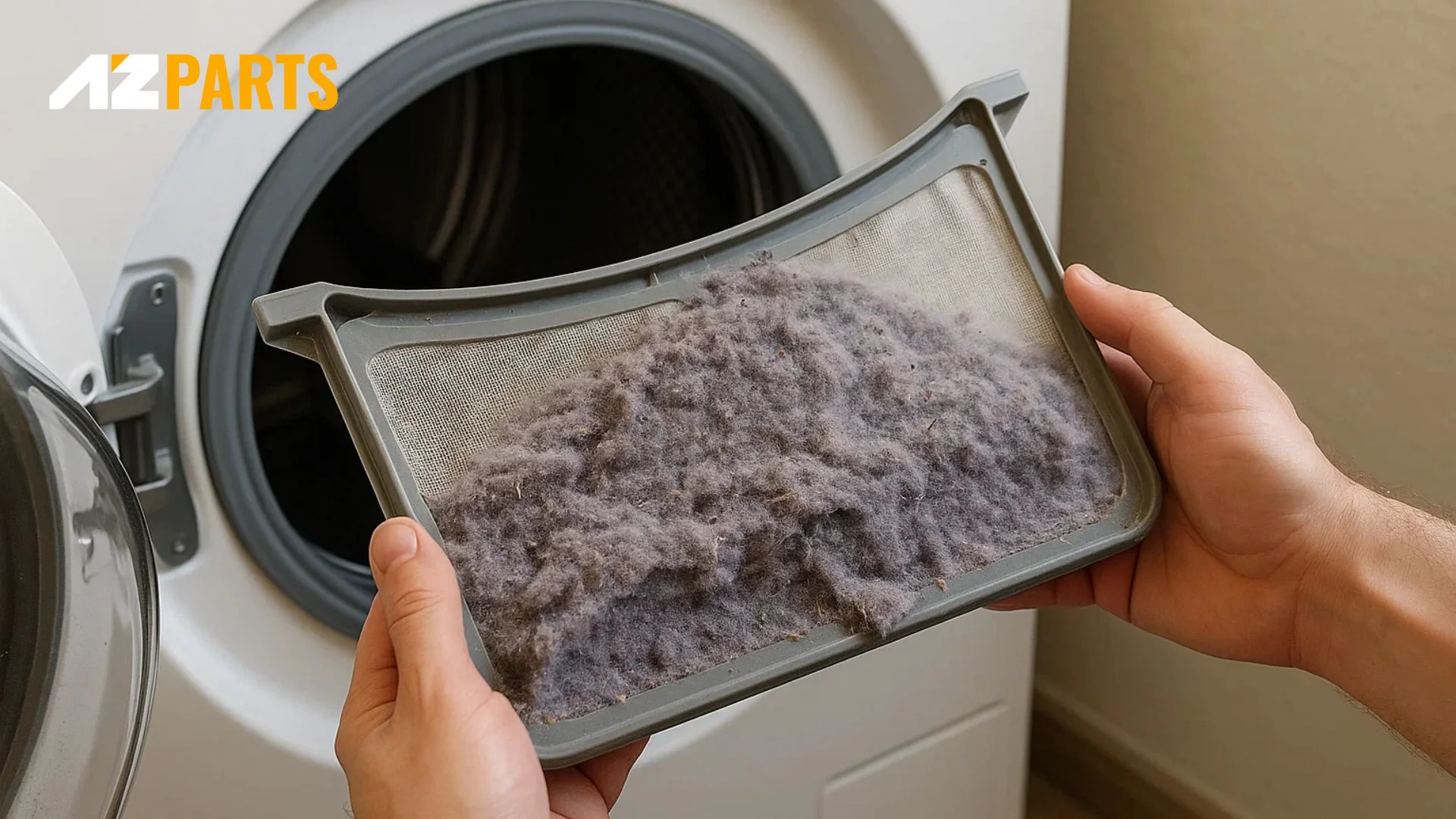
Clogged lint filter is one of the main reason cause burning smell (Source: AZParts)
Regular cleaning after every load is essential, but even with routine maintenance, lint can build up in hard-to-reach areas. The combination of heat, restricted airflow, and combustible lint creates perfect conditions for overheating and potential fire hazards.
1.2 Blocked Dryer Vent
Your dryer vent system extends from the appliance to the exterior of your home, allowing hot, moist air to escape. When this vent becomes blocked with lint, debris, or even small animals, the restricted airflow causes heat to build up inside the dryer. This overheating can cause various components to burn or melt, creating that alarming smell.
A blocked vent doesn't just cause burning smells – it significantly increases drying times and puts enormous strain on your dryer's motor and heating elements. The accumulated heat can damage internal components and create serious fire risks throughout your home's ventilation system.
1.3. Overloaded Dryer
Loading too many clothes into your dryer creates multiple problems that can lead to burning smells. Overloading prevents proper air circulation, causing the dryer to work harder and generate excessive heat. The motor strain from trying to tumble heavy loads can cause drive belts and other components to overheat and produce burning odors.
Additionally, wet clothes packed too tightly take longer to dry, extending cycle times and increasing heat exposure. This prolonged operation at high temperatures can cause various components to degrade and emit burning smells as they begin to fail.
1.4. Worn-Out Drive Belt
The drive belt rotates your dryer drum, and over time, this rubber component can crack, fray, or slip from its proper position. When a worn belt slips against the drum or motor pulley, the friction generates heat and produces a distinct burning rubber smell. A completely broken belt will prevent the drum from rotating entirely.
Drive belt problems often develop gradually, starting with occasional slipping that creates intermittent burning smells. As the belt deteriorates further, the odor becomes more persistent and noticeable. Ignoring these warning signs can lead to complete belt failure and potential damage to other dryer components.
1.5. Faulty Heating Element
The heating element is responsible for generating the warm air that dries your clothes. When this component malfunctions, it can overheat and create burning smells. A faulty heating element might cycle on and off irregularly, produce excessive heat, or develop hot spots that can burn surrounding components.
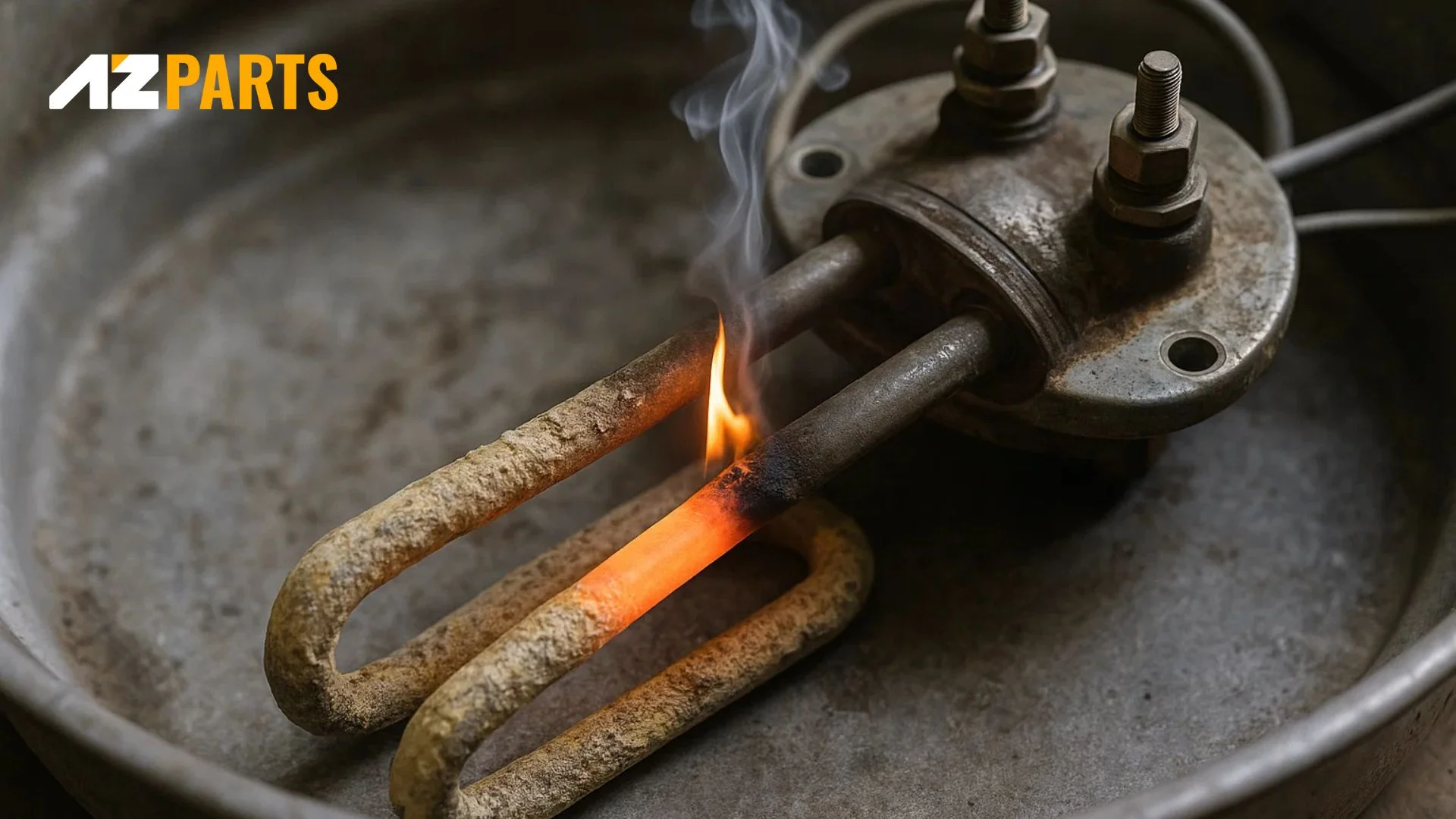
Faulty Heating Element can overheat and create burning smells (Source: AZParts)
Heating element problems can stem from age, electrical issues, or damage from lint buildup. When the element operates outside its normal parameters, it can cause temperature fluctuations that stress other components and create various burning odors throughout the drying cycle.
1.6. Trapped Items in the Drum
Small items like plastic toys, rubber bands, or synthetic materials can fall behind the drum or get caught in the dryer's internal components. When these items come into contact with heated surfaces, they melt or burn, creating strong chemical odors that can be particularly concerning.
These trapped items often produce intermittent burning smells that occur only during certain parts of the drying cycle. The odor might be strongest when the drum rotates in specific positions, bringing the melting item into contact with heating elements or other hot components.
2. How to Troubleshoot a Dryer That Smells Like Burning
When you detect a burning smell from your dryer, following these systematic troubleshooting steps can help identify and resolve the issue safely.
Step 1 – Unplug the Dryer Immediately
The moment you notice a burning smell, stop the dryer cycle and unplug the unit from the electrical outlet. This immediate action prevents further heating and reduces the risk of fire or component damage. Allow the dryer to cool completely before beginning any inspection or maintenance work.
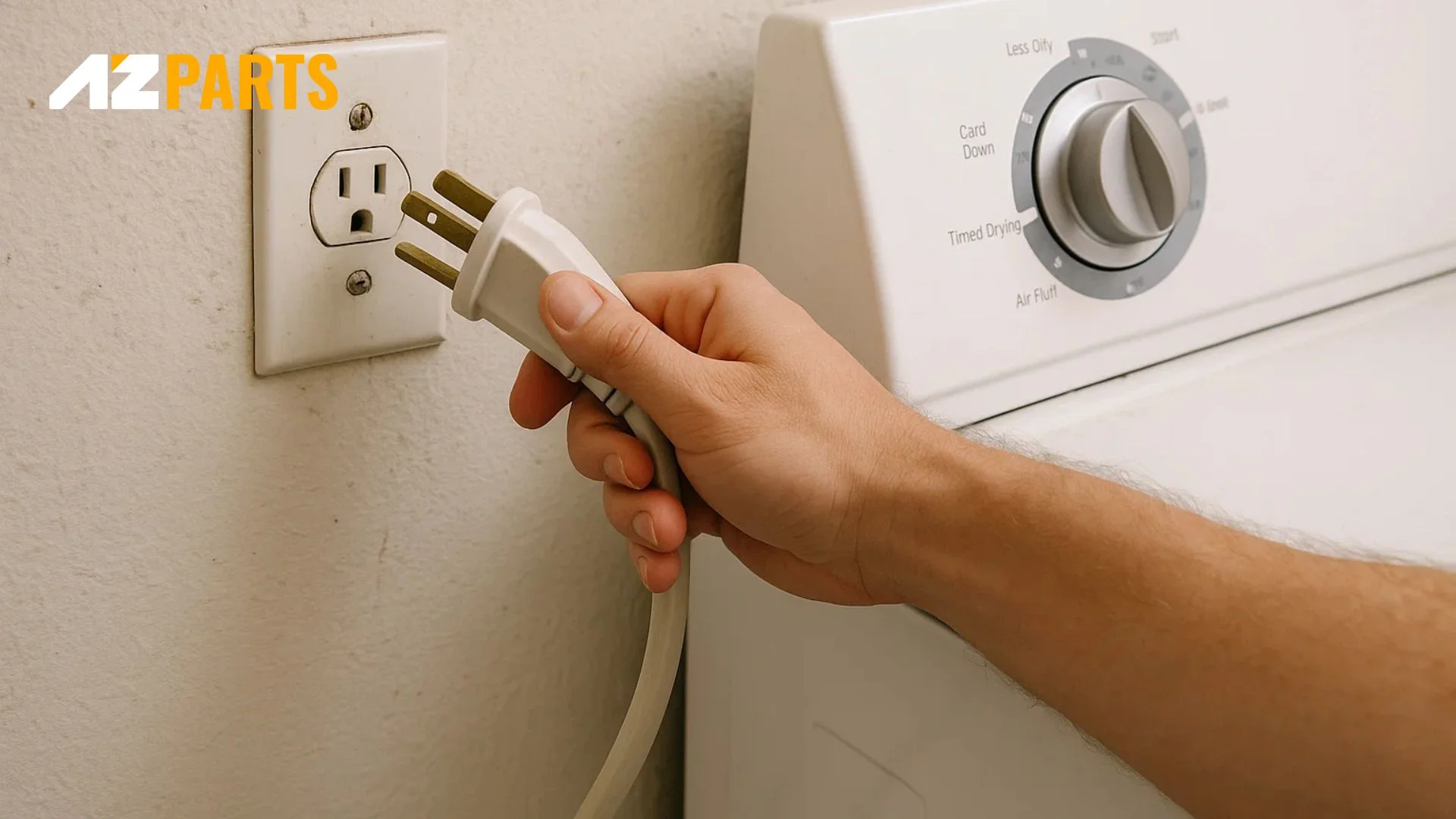
Unplug the Dryer Immediately (Source: AZParts)
Never continue operating a dryer that produces burning smells, even if it seems to be functioning normally otherwise. The smell indicates a problem that could worsen rapidly and create dangerous conditions. Waiting for the unit to cool also makes it safer to handle internal components during your inspection.
Step 2 – Clean the Lint Filter Thoroughly
Remove the lint filter and clean it completely, even if it appears relatively clean. Wash the filter with warm water and mild detergent to remove any fabric softener residue that might be restricting airflow. Check the lint filter housing inside the dryer for accumulated debris that regular cleaning might miss.
Inspect the filter for damage, tears, or warping that could allow lint to bypass the filtration system. A damaged filter can't effectively capture lint, leading to buildup in other areas of the dryer where it can create burning smells and fire hazards.
Step 3 – Check and Clean the Dryer Vent
Disconnect the dryer vent hose from the back of the unit and inspect it for lint buildup or blockages. Use a dryer vent cleaning brush or vacuum to remove accumulated debris from both the hose and the external vent opening. Check that the exterior vent flap opens and closes properly when the dryer operates.
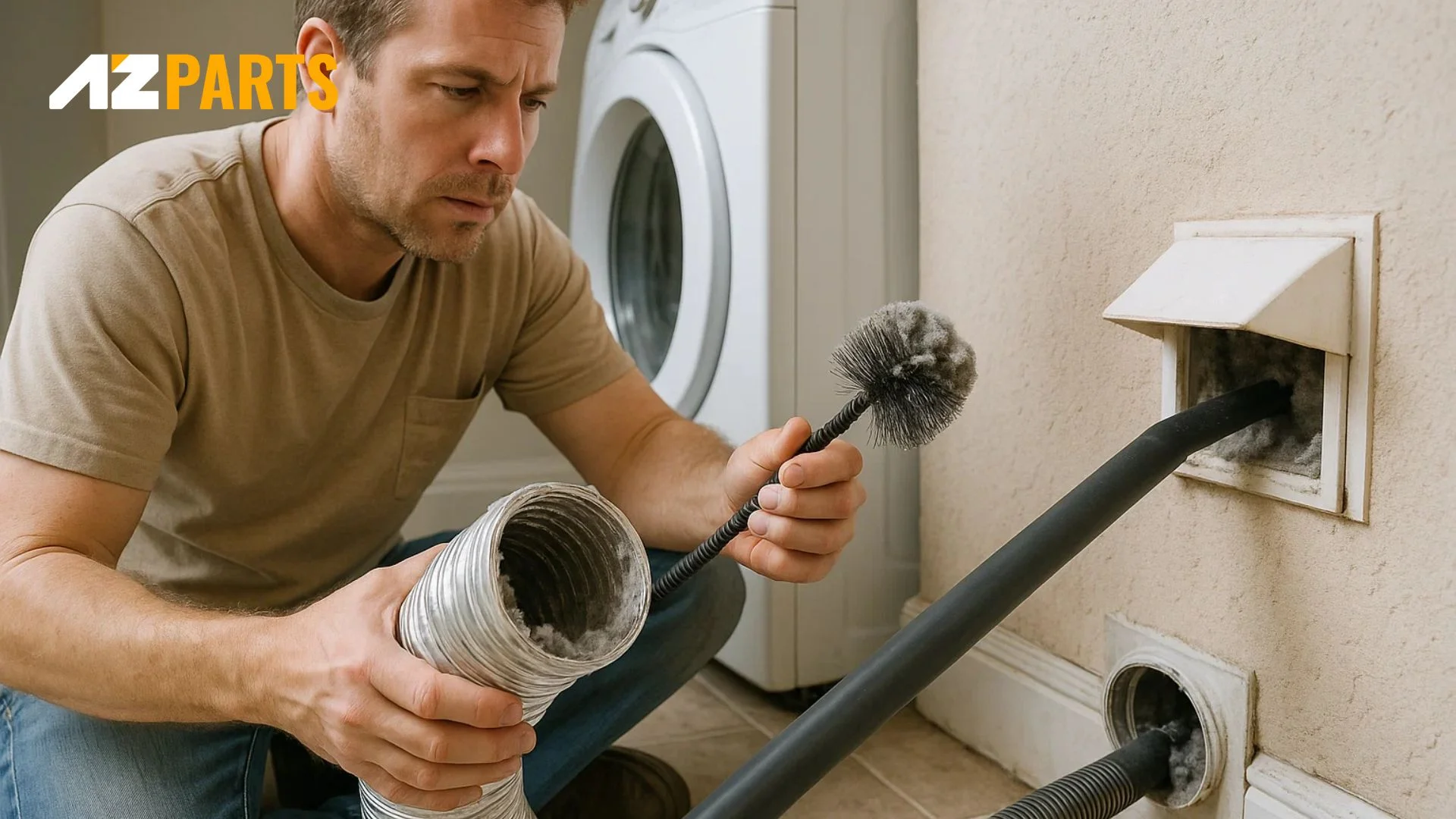
Check and Clean the Dryer Vent (Source: AZParts)
A thorough vent cleaning might require accessing the entire vent run, especially in longer installations. Consider professional vent cleaning services for complex or extensive vent systems that you can't adequately clean yourself.
Step 4 – Inspect the Drum and Drive Belt
With the dryer unplugged and cooled, open the door and manually rotate the drum to check for smooth operation. Listen for unusual noises, grinding sounds, or resistance that might indicate belt problems. Remove the top or front panel (depending on your model) to visually inspect the drive belt for cracks, fraying, or improper positioning.
Check around the drum for any foreign objects that might have fallen behind or gotten caught in the mechanism. Remove any debris, coins, or small items that could cause friction or burning when the dryer operates.
Step 5 – Test the Heating Element and Thermostat
Locate the heating element assembly and visually inspect it for obvious damage, such as broken coils or burn marks. Use a multimeter to test the element's continuity and resistance according to your dryer's specifications. Check the associated thermostats and temperature sensors for proper operation.
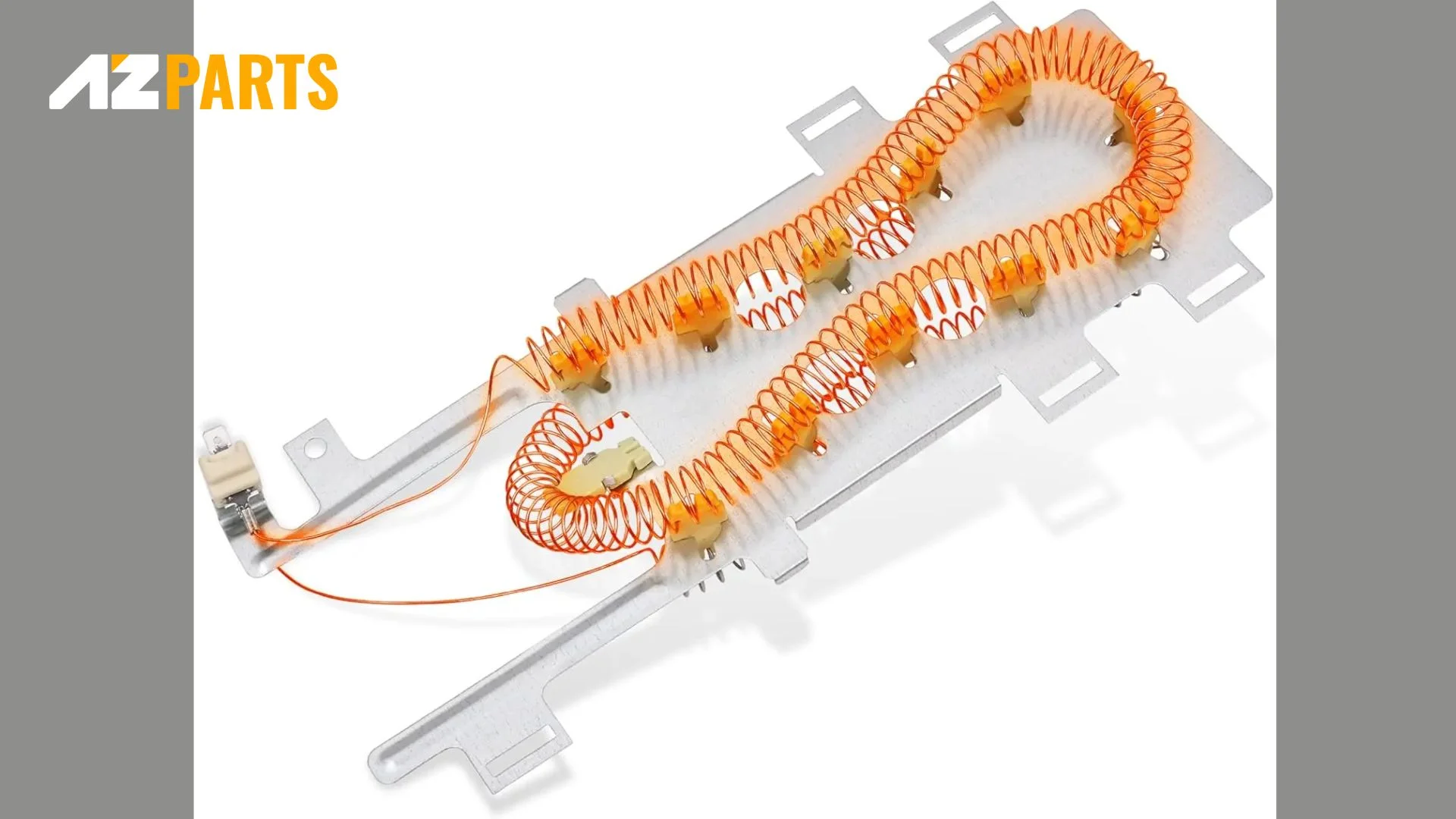
High quality heating element from AZParts (Source: AZParts)
If you're looking for reliable heating elements and thermostats, AZParts has you covered with our comprehensive selection of heating element parts. Our inventory includes genuine heating elements, thermostats, and temperature sensors compatible with all major dryer brands. Professional testing might be necessary if you're not comfortable working with electrical components.
Step 6 – Run a Test Load
After completing your inspection and any necessary cleaning or repairs, run a test load with a few damp towels. Monitor the dryer closely during this test cycle, checking for any return of burning smells, unusual noises, or overheating. Stop the cycle immediately if any problems persist.
The test load helps verify that your troubleshooting efforts resolved the issue and that the dryer operates safely. Use this opportunity to confirm that air flows properly through the vent system and that the unit maintains appropriate temperatures throughout the cycle.
3. What to Do if Your Dryer Starts Smoking
If your dryer begins producing visible smoke, take immediate action to prevent fire and protect your safety. Unplug the dryer immediately and evacuate the area if smoke is heavy or accompanied by flames. Never use water on an electrical fire – use a Class C fire extinguisher if necessary.
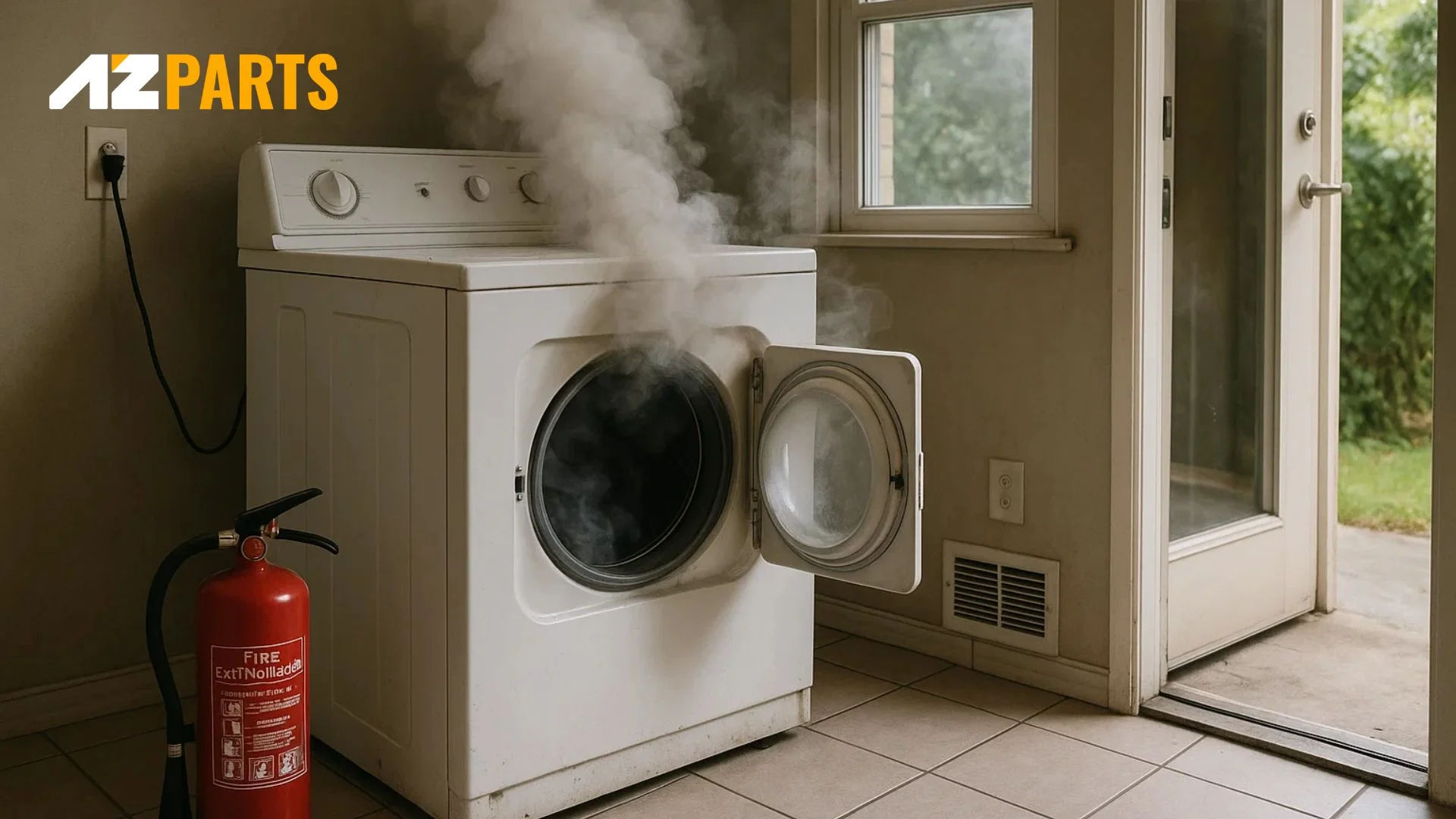
What to Do if Your Dryer Starts Smoking (Source: AZParts)
Open windows and doors to ventilate the area and allow smoke to dissipate. Do not attempt to restart the dryer until a qualified technician has inspected and repaired the unit. Smoke indicates a serious problem that requires professional attention and potentially significant repairs or replacement.
Contact your insurance company if smoke has caused damage to your home or if you're concerned about fire damage. Document the incident with photos and keep records of any repairs or replacements needed.
4. How to Prevent Burning Smells From Your Dryer
Prevention is always better than dealing with emergency repairs and potential safety hazards. Implementing these maintenance practices will help keep your dryer operating safely and efficiently.
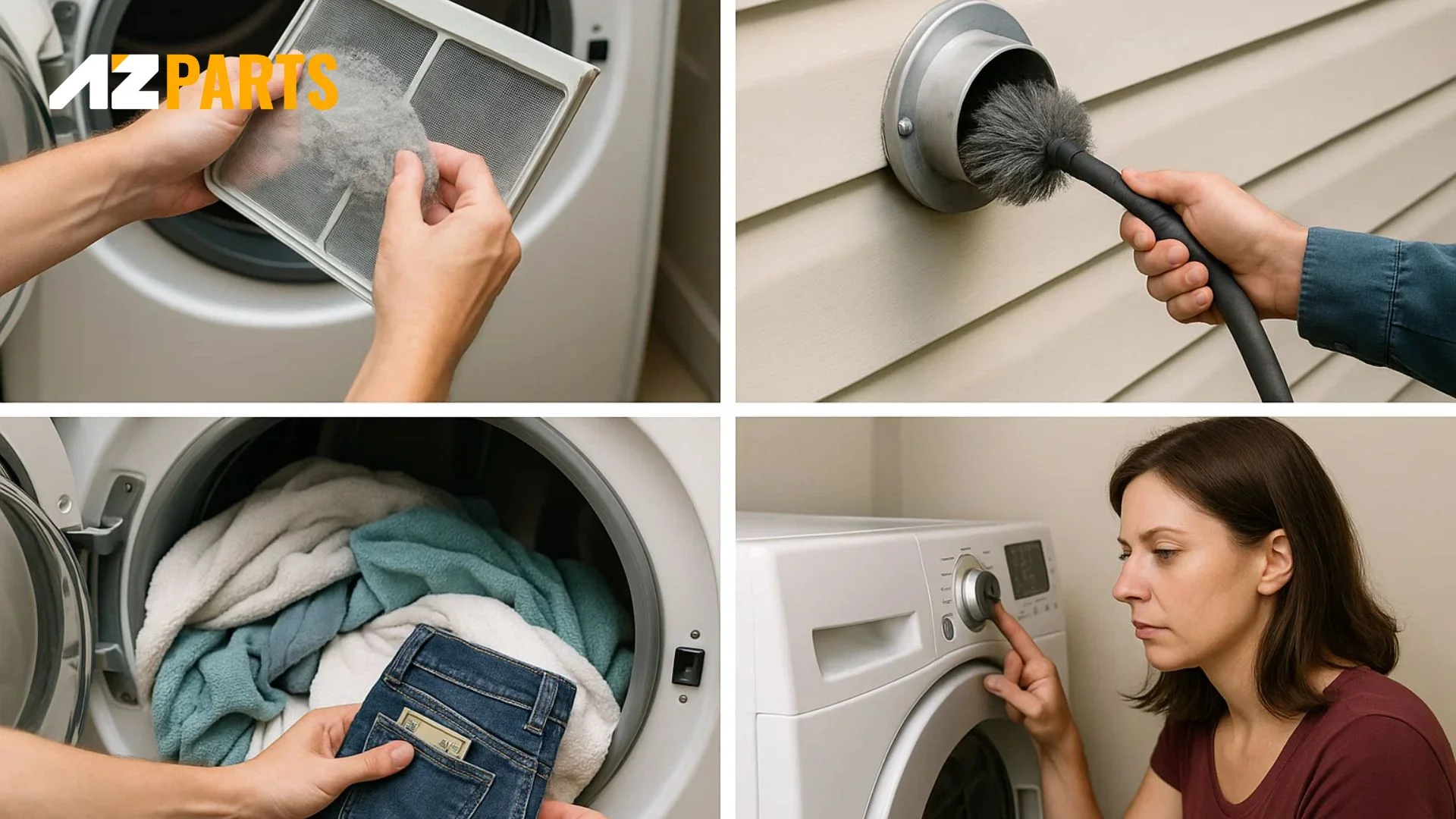
How to Prevent Burning Smells From Your Dryer (Source: AZParts)
Clean the lint filter after every load, and perform a thorough washing of the filter monthly to remove fabric softener buildup. Schedule annual professional vent cleaning to maintain proper airflow and prevent dangerous lint accumulation in your home's ventilation system.
Avoid overloading your dryer, and separate heavy items like towels and bedding from lighter fabrics. Check pockets for small items, tissues, or anything that could melt or burn before starting each load. Replace worn components promptly when you notice signs of deterioration.
Monitor your dryer's performance regularly, noting any changes in drying times, unusual noises, or odors that might indicate developing problems. Address minor issues before they become major safety hazards or expensive repairs.
5. FAQs
5.1. Is a burning smell from my dryer dangerous?
Yes, a burning smell from your dryer is potentially dangerous and should never be ignored. It indicates overheating, component failure, or fire hazards that require immediate attention. Stop using the dryer immediately and investigate the source of the smell before operating the appliance again.
5.2. Why does my dryer smell like burning plastic?
A burning plastic smell usually indicates that synthetic materials, plastic items, or rubber components are overheating or melting. This could be from items trapped in the drum, a deteriorating drive belt, or plastic components near the heating element. Check for foreign objects and inspect rubber seals and belts for damage.
5.3. Can a dirty lint trap cause a fire?
Absolutely. A dirty lint trap restricts airflow and allows combustible lint to accumulate near heating elements. The Consumer Product Safety Commission reports that failure to clean lint traps is a leading cause of dryer fires. Clean your lint filter after every load and perform deeper cleaning regularly to prevent dangerous buildup.
A burning smell from your dryer is a serious warning sign that requires immediate attention and proper troubleshooting. By understanding the common causes and following systematic repair steps, you can address most issues safely and prevent dangerous situations. Regular maintenance, proper loading techniques, and prompt attention to warning signs will keep your dryer operating safely for years to come.
When you need quality replacement parts for your dryer repairs, trust AZParts to provide reliable components that meet or exceed manufacturer specifications. Our extensive inventory of dryer replacement parts includes everything from dryer heating elements and drive belts to lint filters and thermostats, ensuring you can find the exact components needed for safe and effective repairs. Don't let a burning smell turn into a dangerous situation – take action today to protect your home and family.
Contact Information:
8 The Green, Ste A, Dover, Delaware 19901-3618, United States
Learn more about other common dryer problems and how to resolve them:
Dryer
Further Reading
Further Reading




